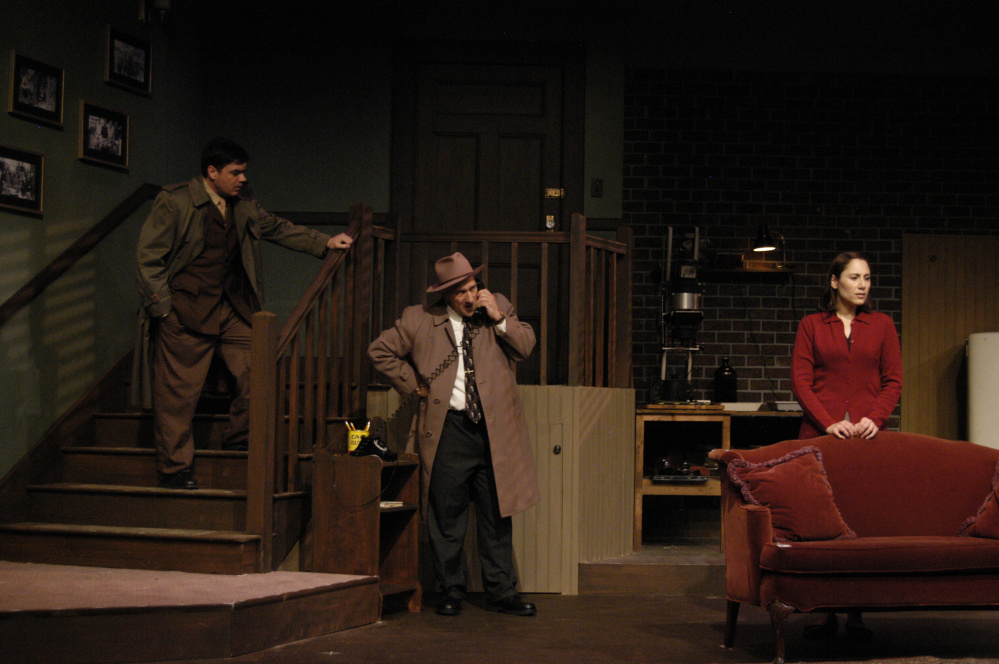Imagine what it would be like to be deceived and menaced by brutal con men while trapped in a small city apartment. Further, imagine what that would be like if you were blind. That’s the essential situation in the opening production of The Public Theatre’s 25th season.
Successful on stage and screen in the 1960s, Frederick Knott’s “Wait Until Dark” was updated by Jeffrey Hatcher a few years back. Hatcher sought to solidify the already “noirish” feel of the play by setting it back to the 1940s. Taking place entirely in a mostly dim, below-street-level apartment, it tells the tale of a blind woman whose husband unknowingly comes into possession of a doll that some bumbling but potentially lethal bad guys want.
A Hitchcock-style thriller, the play can still get audience hearts pounding, as it does in this appealing production. But its thrills come with a lot of dramatic setting-up that requires a bit of patience.
The hoods, played by Jon Krupp, Michael Serratore and Jason Cadieux, create a rather elaborate scam to trick the woman, played by Amy Hutchins, into revealing where the doll and its valuable contents are. Fake identities, carefully contrived backstories, elaborate signaling and more fill the first half of the play.
The second act cuts to the chase, pulling it all together with suspenseful action that pays for all the talk-filled ramping up that preceded it.
The female characters fare better in the play and have inspired fine performances in this Janet Mitchko-directed production. First on the list is Hutchins, who has studied the ways of recently blinded people (her character is sightless from an accident that occurred 18 months prior to the time of the play) and gives a credible physical performance. She also makes Susan someone to root for because of her intelligence and resourcefulness. As her girlish laughter gives way to tough talk, she remains likable as a person very able to move beyond her self doubts (and ultimately to save the day).
Local high-schooler Ella S.G. Werner was also memorable as the bratty young neighbor who knows to do the right thing when danger is near. Her interactions with Hutchins have that extra something that makes one feel like there’s a real relationship there.
Though Cadieux’s character conveys some genuine humanity as the show moves along, the other criminals seem stuck in a universe that perhaps has become too familiar to contemporary audiences. The play seems most dated when they offer their supposedly menacing lines, designed to reveal how twisted they are. The street-accented banter often was taken as comic relief by the crowd, but a little more believability also would have been welcome. To be fair, history shows that these roles, as written, have tripped up a number of actors.
Jon L. Peacock has a small role as the WWII battle-scarred husband, adding to the play’s subtext of characters living under post-traumatic stress, whether from war, accident or family abuse.
The multilevel set design by Jennifer B. Madigan, period costume design by Joan Larkins Mather and complex lighting design by Bart Garvey all serve to give this production the right look, even when the stage is dark.
Steve Feeney is a freelance writer who lives in Portland.
Copy the Story LinkSend questions/comments to the editors.



Success. Please wait for the page to reload. If the page does not reload within 5 seconds, please refresh the page.
Enter your email and password to access comments.
Hi, to comment on stories you must . This profile is in addition to your subscription and website login.
Already have a commenting profile? .
Invalid username/password.
Please check your email to confirm and complete your registration.
Only subscribers are eligible to post comments. Please subscribe or login first for digital access. Here’s why.
Use the form below to reset your password. When you've submitted your account email, we will send an email with a reset code.